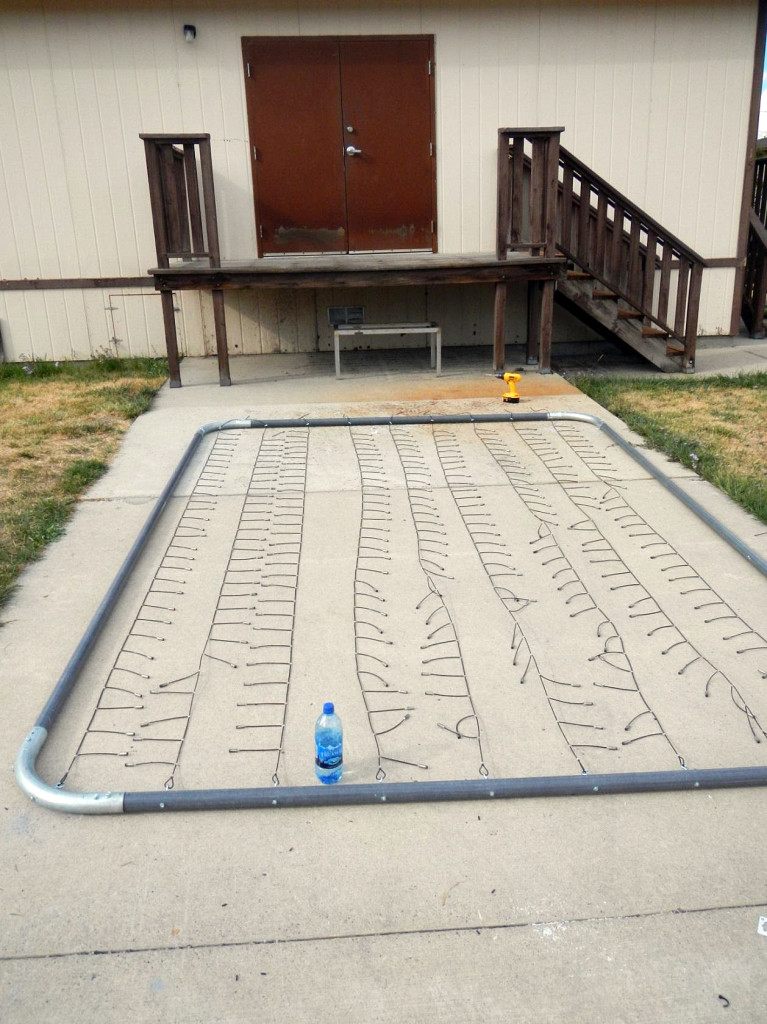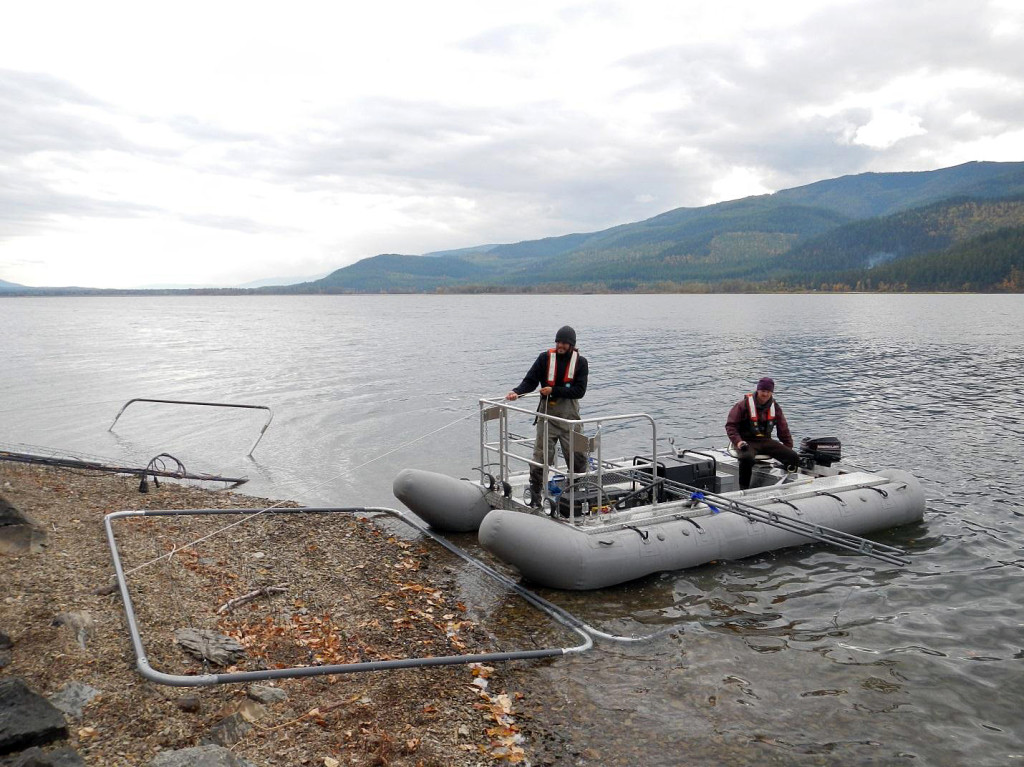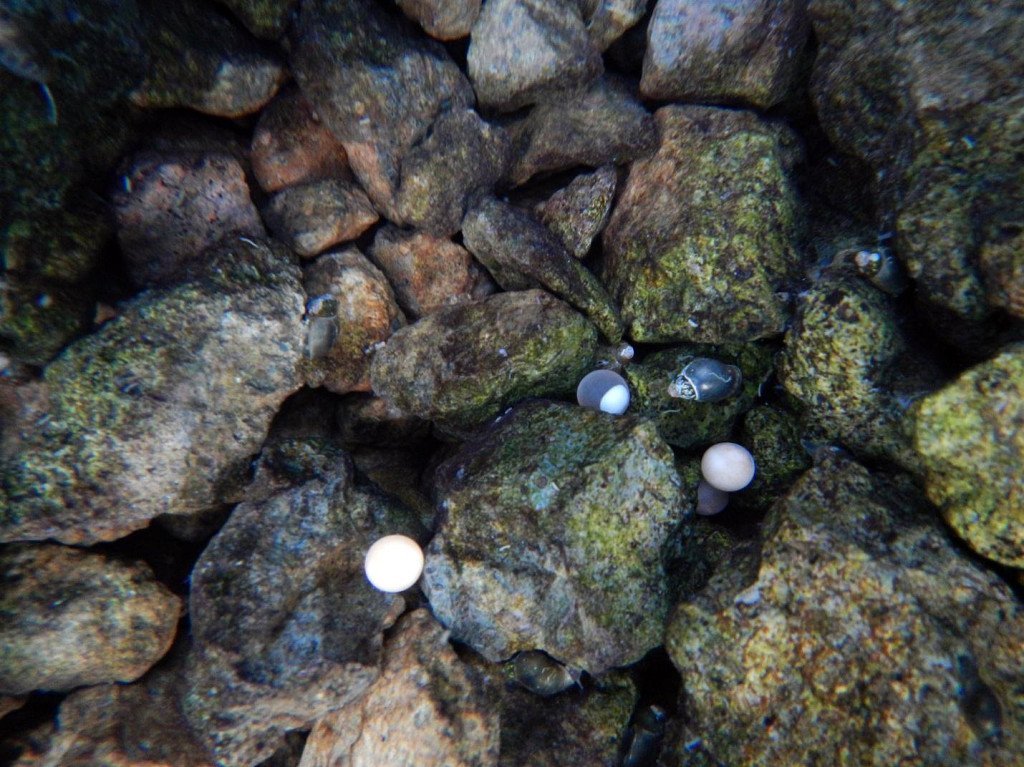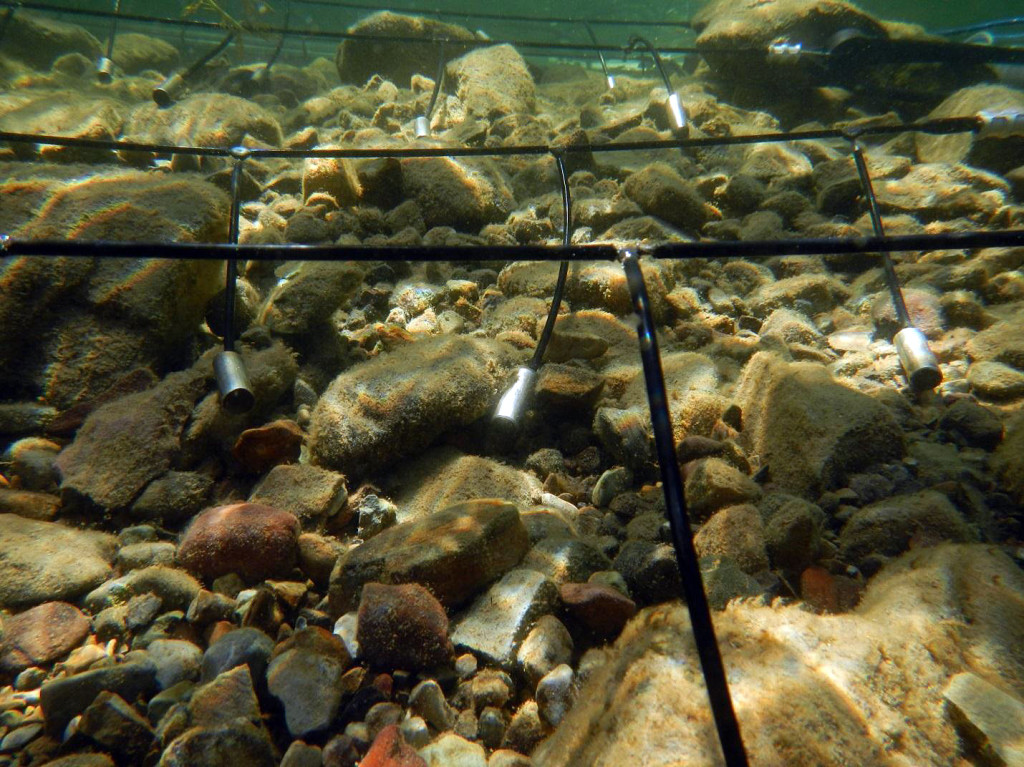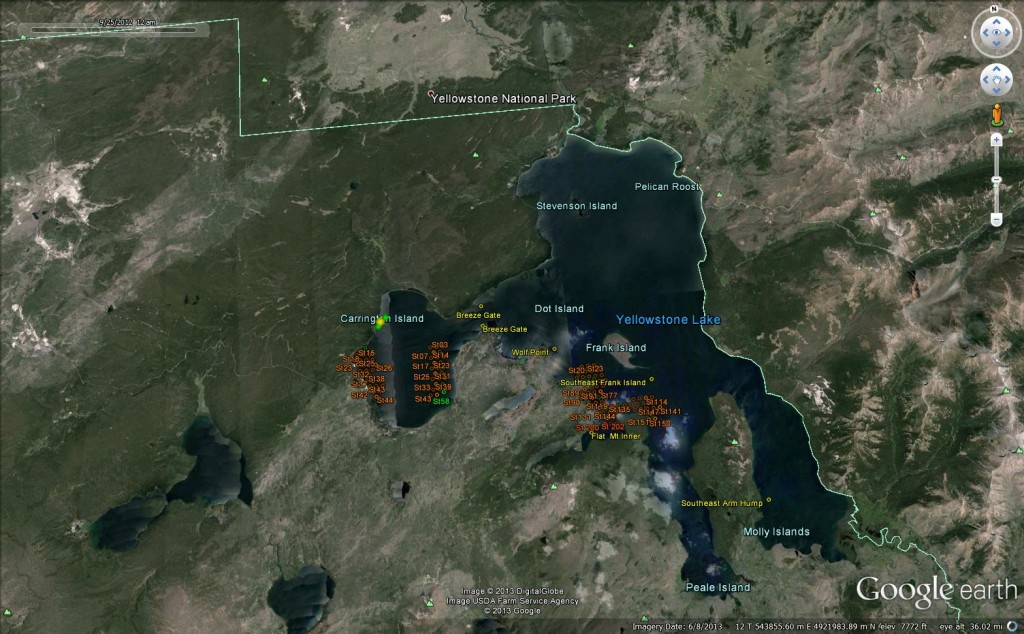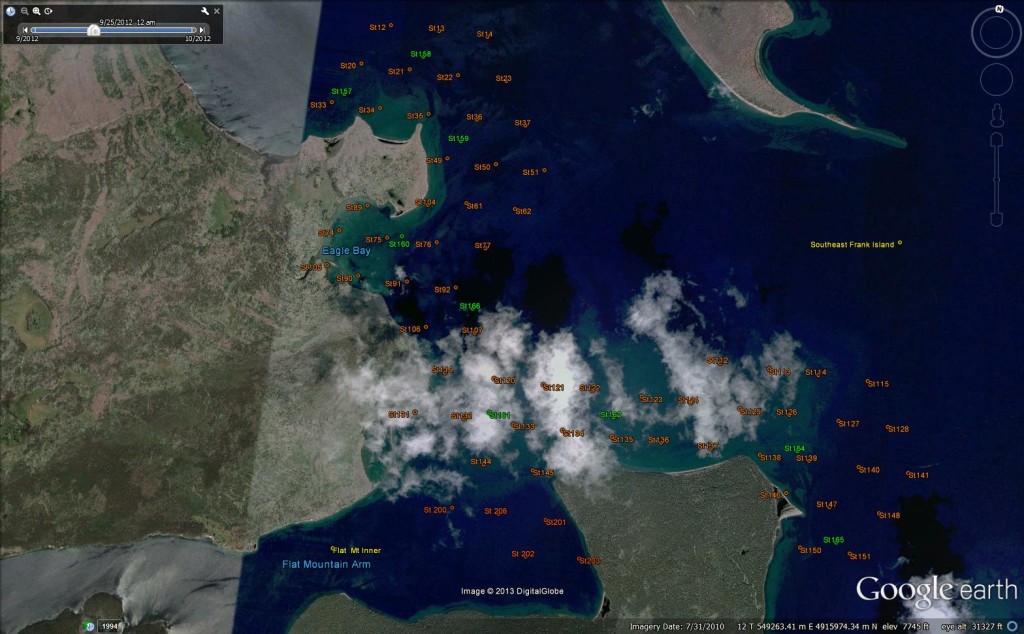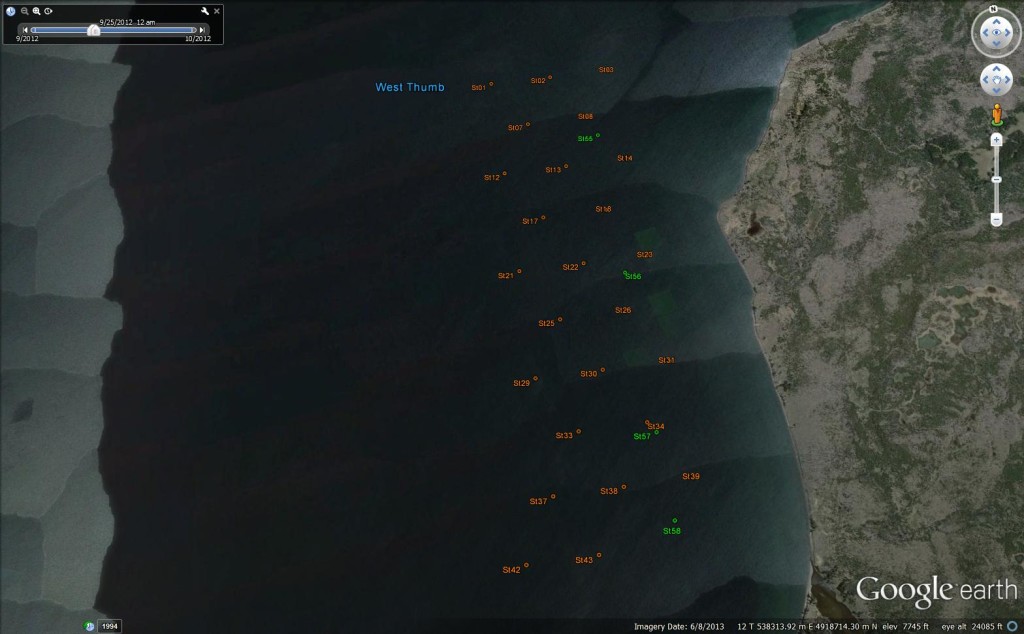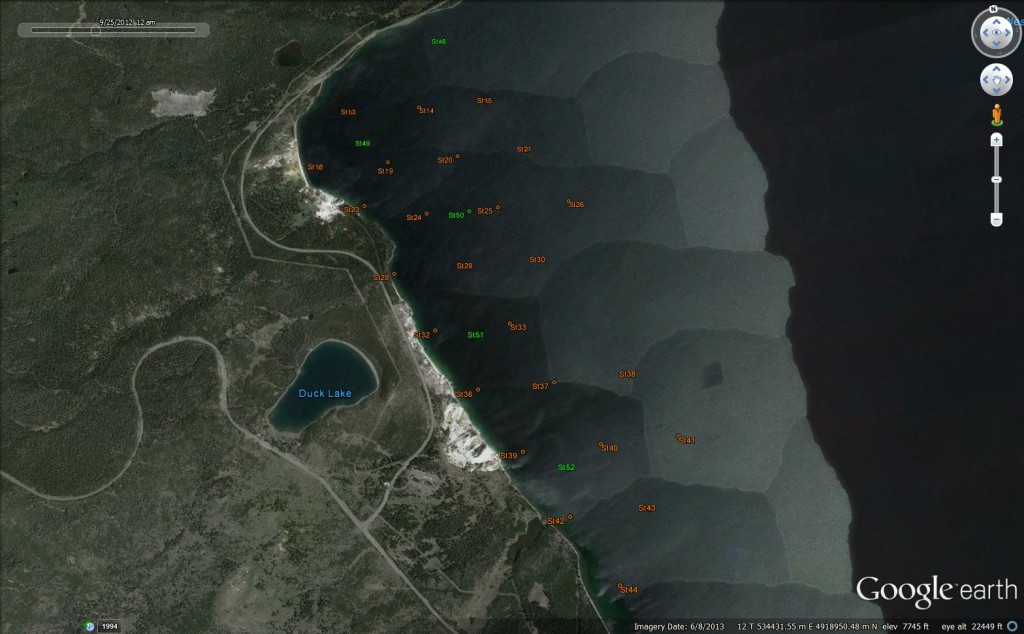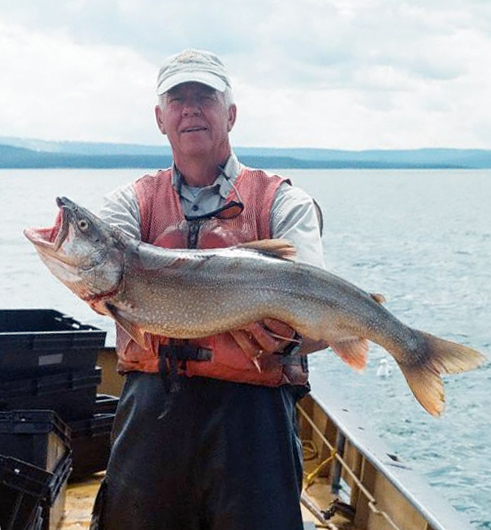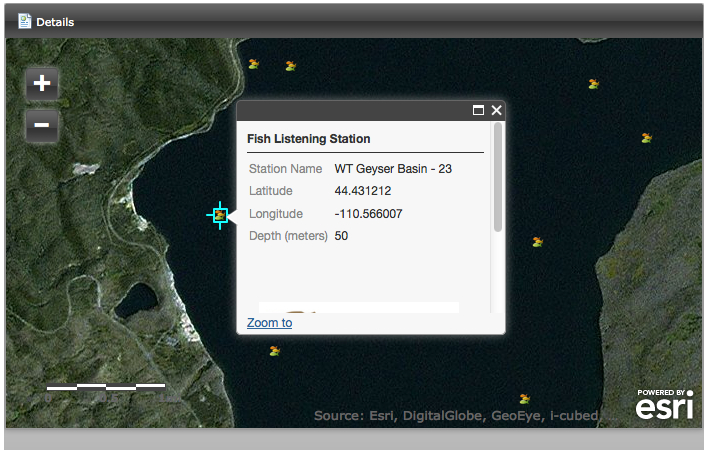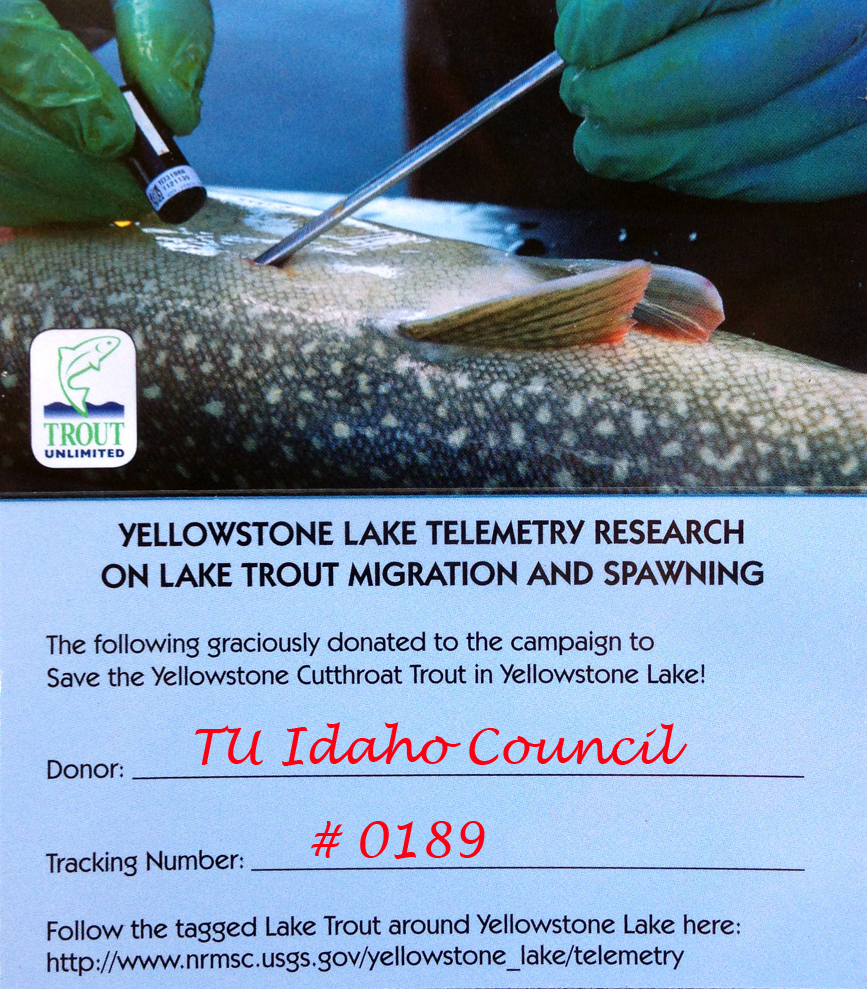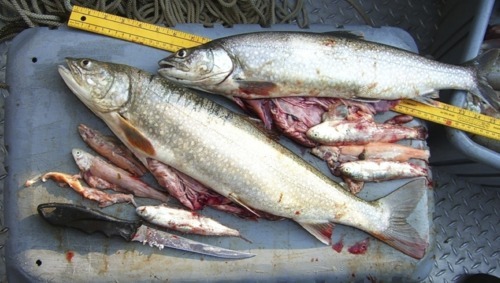
Lake Trout eat native Yellowstone cutthroat trout
Help us Save the Yellowstone Cutthroat Trout in Yellowstone Lake!
Posted by John C. Ellsworth, Idaho Trout Unlimited’s Yellowstone Cutthroat Coordinator
Yellowstone National Park Fisheries Supervisor honored for work restoring Yellowstone cutthroat trout in Yellowstone Lake
Todd Koel, fisheries supervisor in Yellowstone, was recently awarded the 2015 Regional Director’s Award for Natural Resource Management by the National Park Service (NPS). Todd has been the lead NPS fisheries biologist on our Yellowstone Lake working group in our efforts to restore the native Yellowstone cutthroat trout in Yellowstone Lake.
According to an NPS press release:
“The award honors Todd for his significant contributions in reversing decreasing trends in native fish populations and associated losses of ecosystem function in Yellowstone. He also led the restoration of native Arctic grayling and cutthroat trout to several watersheds and intensified efforts to suppress nonnative lake trout and restore cutthroat trout in Yellowstone Lake.”
For more details, visit the Trout Unlimited national website here:
http://www.tu.org/blog-posts/tu-partner-in-yellowstone-national-park-honored-for-his-efforts
Congratulations, Todd!
Posted by John C. Ellsworth, Idaho Trout Unlimited’s Yellowstone Cutthroat Coordinator
Progress Report on suppressing lake trout and restoring native Yellowstone cutthroat trout
The TU Idaho Council met on October 17, 2015 in Hailey to receive the latest report on Saving the Yellowstone Cutthroats in Yellowstone Lake and pledged additional financial support.
Background
The Yellowstone Lake working group is composed of Yellowstone National Park, US Geological Survey, Trout Unlimited in Idaho, Montana, Wyoming, and TU National, the Greater Yellowstone Coalition, the National Parks Conservation Association, and the Yellowstone Park Foundation.
Progress Summary
The following is provided by Dave Sweet, WY TU Yellowstone Lake Special Projects Manager (September 9, 2015).
This summer, the netting operation is proceeding full speed and early results indicate that we continue to make a significant impact on the adult lake trout population. Final netting results won’t be available until November but preliminary numbers are encouraging. Over the past four years the lake trout population has been roughly halved. The telemetry study is also progressing. Summer placement of receivers continues to indicate travel patterns and seasonal congregations of lake trout. Fall receiver arrays are now in place that will be used to confirm or locate suspected spawning areas with confirmation by a combination of diving/robotic photography/egg collection/fry detection. The NPS is actively pursuing ova/fry suppression by electro-shocking and vacuum technology which gives us great hope for a less expensive and longer term lake trout suppression strategy. Meanwhile, the cutthroat population continues its recovery. Each of the past four years has shown an increasing total number of cutthroats in the system and a major increase in the survival of juvenile and mid-age cutts. This last trend is very significant and rewarding.
The exciting core message we want to continue to communicate to the public and our project supporters is:
The lake trout decline in Yellowstone Lake is resulting in an increase in native Yellowstone cutthroat trout populations, and we must continue the work of restoring the Yellowstone cutthroat trout to its rightful place in the Yellowstone Lake system.
The Costs of Saving the Yellowstone Cutthroats in Yellowstone Lake
The total annual cost of the efforts is $1,800,000 including the cost of the telemetry operations alone which is approximately $357,000. TU Idaho and our partners in fishing clubs and other organizations have raised a total of $15,977 over the last few years. Montana TU has committed to $10,000 per year for the next three years and Wyoming TU much more. The Yellowstone Park Foundation raises approximately $1,000,000 annually. The USGS annually provides $112,000 in personnel costs and the Greater Yellowstone Coalition contributes $20,000 annually.
Fundraising
The total project fundraising from TU, GYC [Greater Yellowstone Coalition], NPCA [National Parks Conservation Association], and IFFF [International Federation of Fly Fishers] now stands at just under $1,060,000 with just over $1M of that coming through TU … the WWNRT [Wyoming Wildlife and Natural Resources Trust fund administered through the Wyoming state legislature] grant is $771,000 of that number leaving about $230,000 coming from our TU members and supporters.
We have made progress but more funds are needed this year.
Idaho Council asked to continue support for this project …
In order to match the three-year $771,576 grant from the Wyoming legislature through their Wyoming Wildlife and Natural Resources Trust Fund, the partner organizations need to raise $137,000. We have made progress but more funds are needed this year. Montana TU has committed to $10,000 per year for the next three years and Wyoming TU much more.
… the Council steps up …
At their meeting in Hailey, the Council continued to take the lead in this “One TU” effort, pledging up to $1,000 by matching $1 for every $2 raised by TU Idaho Chapters!
… and chapters and members can now respond!
The call went out, and as of this writing donations have already been pledged and more are being considered by TU Idaho Chapters and members around the state. For those wishing to donate personally, please click the “donate” button at the top of this web page.
Thank you all!
Posted by John C. Ellsworth, Idaho Trout Unlimited’s Yellowstone Cutthroat Coordinator and Andy Brunelle, TU Idaho Council
Updated telemetry tracking of your lake trout Judas fish!
Thanks to the hard work of the US Geological Survey (USGS) staff, we now have videos showing the movement of YOUR lake trout Judas fish in Yellowstone lake from fall 2013 through fall 2014, the latest comprehensive data available!
The last posting of lake trout telemetry tracking videos was in summer 2013 (scroll down this page to the June 15, 2013 post to see those). Since then, some tags have been lost, some fish have died and taken their tags to the lake bottom with them, and some tags have simply failed. Therefore, many of the lake trout for our Idaho donors have been assigned new tag numbers.
Although the videos are not yet loaded onto the USGS website, through special arrangement between Idaho TU and USGS we now have our Idaho sponsors’ videos available for you to view on YouTube and right here! Simply scroll through the videos below to see yours, and all the others sponsored by Idaho Trout Unlimited and various clubs around the state.
Before you do, here are some helpful hints about what you’ll see in the videos:
Each time your Judas fish swam within range of a telemetry receiver, it’s presence was recorded and is displayed in the video as a small black diamond.
In order to keep the size of the video files manageable, each frame of video represents a 3 day period. As a result, there will be some frames with no black diamonds (your fish) showing.
At other times in the videos, there will be multiple black diamonds at the same time, sometimes at quite some distance from one another, indicating the fish was moving rapidly.
Throughout the majority of each video you will see some activity. If the black diamond disappears with time left at the end of the video, it usually indicates the fish is simply out of range of a receiver, or the fish has died and taken the transmitter to the lake bottom, or perhaps the transmitter has failed at that point in time.
If the black diamond stays in one place for several frames, it usually means the fish is loitering in that area.
To access the following video play options, start the video then hover your mouse over any part of the video and you will see a menu bar appear at the bottom of the video screen:
To watch the video in full screen, click the “full screen” icon in the lower right hand corner,
If you want to speed up or slow down the video, click the little gear icon to the left of the YouTube logo in the lower right corner and it will show playing speed options,
And if you want to view the video on YouTube, click the YouTube icon.
Now, click on your video and enjoy watching your Judas fish betray his or her brethren in Yellowstone Lake while helping us Save the Yellowstone Cutthroat Trout!
April 13, 2015
Posted by John C. Ellsworth, Idaho Trout Unlimited’s Yellowstone Cutthroat Coordinator
PROGRESS REPORT on SAVING THE YELLOWSTONE CUTTHROAT TROUT IN YELLOWSTONE LAKE
Presented to the Idaho Council of Trout Unlimited Spring Meeting
April 11, 2015 — Boise, Idaho
by John C. Ellsworth, TU Idaho Council Yellowstone Cutthroat Coordinator
(LKT = Lake Trout … YCT = Yellowstone Cutthroat Trout)
Following is a summary of progress on suppressing LKT in 2014, as reported at the Feb. 3, 2015 meeting of the working group (composed of Yellowstone National Park, US Geological Survey, Trout Unlimited in Idaho, Montana, Wyoming, and TU National, the Greater Yellowstone Coalition, the National Parks Conservation Association, the International Federation of Fly Fishers, and the Yellowstone Park Foundation).
Executive Summary
The exciting core message for the public and our project supporters is:
The lake trout decline in Yellowstone Lake is resulting in an increase in Yellowstone cutthroat trout populations, and we must continue the work of restoring the Yellowstone cutthroat trout to its rightful place in the Yellowstone Lake system.
Overall CPUE (Catch Per Unit Effort) is now less than half of what it was just a few years ago which is an indicator of declining LKT numbers. Also contributing is the later start date. In 2014, 277,000 LKT were netted. There is still a large population of LKT in the lake, so it may be several years before a population crash. Cutthroat trout catches in nets is trending upwards both in total numbers and in more optimal size distributions (numbers of small and mid-sized cutthroats). They are catching fewer mature LKT in the LKT distribution netting. We have now recorded the second straight year in a row of LKT declines (as measured by CPUE and population estimates) and the third straight year in a row of YCT increases in both total numbers and especially in young and mid-aged YCT survival (as measured by distribution netting, YCT by-catch, and spawning stream surveys). There was a drop in estimated total mortality rate for lake trout, but it’s 2nd highest we’ve achieved (just behind last year), helping to further decrease total population of lake trout in the lake. The data show the northern area of Yellowstone Lake has fewer LKT and the highest likelihood of LKT is in the West Thumb, the southern arms, and the area along the southeast shore between the two. Over the past year, 31 LKT and 14 YCT were tagged with tracking devices. This leaves a total number tagged in the system at roughly 139 LKT and 14 YCT, and at least 50 more LKT will be tagged in the coming summer. The telemetry goals for 2015 are as follows: 1) locate spawning sites, 2) locate areas where LKT concentrate during netting seasons, 3) determine periods of greatest LKT movement, and 4) determine fish travel corridors. Suspected spawning sites include Carrington Island, Olsen Reef, and Snipe Point. They hope to have the videos of individual tagged LKT movements updated on the USGS website within a couple of months. Electro-shocking results found many more eggs dead than alive after shocking around Carrington Island, Snipe Point, and Olsen Reef. Netting goals for 2015 include to match days on the lake from the previous year. Monitoring will continue, especially in the fall, to identify spawning areas. Similar to last year, Park staff will be attending public meetings in Park gateway communities to update attendees on the park-wide native fish conservation program. Funds raised by the partner organizations as of 4/2/15 (2008-2015 campaigns totals) is $1,050,990 with $549,206 total spent. All of the remaining funds are available for telemetry work.
Continuing funding support is essential to continuing success! In order to match the three-year $771,576 grant from the Wyoming legislature through their Wyoming Wildlife and Natural Resources Trust Fund, the partner organizations need to raise $137,000 in cash in 2015. Montana TU has committed to $10,000 per year for the next three years and Wyoming TU much more. The Idaho Council has generously supported this project for several years.
NOW IS THE TIME for Idaho TU Chapters and individuals, as well as all other Idaho anglers and supporters of the Yellowstone cutthroat trout to make your 2015 financial donation to the Save the Yellowstone Cutthroat telemetry tracking fund-raising effort!
PLEASE USE THE “DONATE” BUTTON FOUND AT THE TOP OF THIS PAGE AND ELSEWHERE ON THIS WEBSITE TO MAKE YOUR 2015 DONATION NOW!
Yellowstone Lake geologic map showing subsurface topography, and areas cited in Progress Report (South Arm, Southeast Arm, Flat Mountain Arm, Snipe Point, Plover Point, et al).
Note: Carrington Island (red spot) lies just off the NW shore of West Thumb.
source: www.yellowstone.co
Now, the details of our progress in Saving the Yellowstone Cutthroat Trout in Yellowstone Lake …
2014 Netting Results
Pat Bigelow, Yellowstone National Park fisheries biologist reported a 20% increase in netting effort resulting in 74,000 total effort units (small and large mesh nets). Overall the catch per unit of effort (CPUE) this year went down from 6.62 to 5.1 for small mesh net and 1.99 to 1.84 for large mesh net. Overall CPUE is now less than half of what it was just a few years ago which is an indicator of declining LKT numbers. Also contributing is the later start date. In 2014, 277,000 LKT were netted. Fewer fish were netted this year because boats were unable to access the lake in the early spring due to the late ice off. Bigelow reported that boats were able to net in the southern bays this year. Catches of YCT in gillnets increased this year but the rate is still near 5% because effort units greatly increased. Dr. Robert Gresswell, USGS and lead researcher on this project pointed out there is still a large population of LKT in the lake, so it may be several years before a population crash.
Yellowstone Cutthroat Trout Population Response
Jeff Arnold, with the Yellowstone Center for Resources reported on the Yellowstone cutthroat population response. He’s using three monitoring protocols: 1) spawning visual surveys (11 stream sites), 2) distribution netting (24 sites – 4 lake regions) and 3) fall netting assessment. Arnold reported there were 160 spawning visuals this past year. Of those, 120 were in one creek, Little Thumb. Arnold said that 40 visuals per visit is the optimal goal. Distribution nets were set at three different depths on the lake. Arnold reported that cutthroat catches in nets is trending upwards both in total numbers and in more optimal size distributions (numbers of small and mid-sized cutthroats). He also reported they are catching fewer mature LKT in the LKT distribution netting. The data show that the northern area of Yellowstone Lake has fewer LKT and the highest likelihood of LKT is in the West Thumb, southern arms, and the area along the southeast shore between the two. To date, cutthroat caught by recreation anglers on Yellowstone Lake continues to rise but has not met the desire of 1.5 fish per hour per angler.
Lake Trout Telemetry Study and Ova/Fry Results
Dr. Gresswell presented the LKT telemetry study and ova/fry results from the past year. The goals are to: 1) determine movement patterns, 2) determine environmental factors, and 3) identify LKT spawning areas. Gresswell reported that LKT are using different areas of the lake that fluctuate depending on the season. Gresswell said the research team will be relying more on partner organizations to address many different questions concerning telemetry rather than taking on one issue or question at a time. This will hopefully create faster research results. Over the past year, 31 LKT and 14 YCT were tagged with tracking devices. This leaves a total number tagged in the system at roughly 139 LKT and 14 YCT, and at least 50 more LKT will be tagged in the coming summer. The telemetry goals for 2015 are as follows: 1) locate spawning sites, 2) locate areas where LKT concentrate during netting seasons, 3) determine periods of greatest LKT movement, and 4) determine fish travel corridors. Gresswell discussed the work completed this fall to track spawning fish on Carrington Island through the deployment of egg collection bags. Fifty percent of the bags were collected in October and the remaining bags after ice off. One finding is that areas without cobbles had higher LKT egg density. Also, LKT fry tend to stay in the same spawning area well after emergence. Gresswell stated that eggs drop quickly and swell once they are fertilized and are easily lodged between rocks. Suspected spawning sites include Carrington Island, Olsen Reef, and Snipe Point. Gresswell also reported on the Gonadal Semantic Index (GSI), which studies when LKT are mature enough to spawn. Lake trout that have previously spawned have higher levels of GSI. Also, a LKT that has previously spawned may not spawn the next year. The GSI studies are ongoing.
Carrington Island as viewed from NW shore of West Thumb.
Note: Pelican on left, for scale.
(image copyright © 2013 C.L. Mori all rights reserved, used with permission).
Electro-Shocking Trials
Phil Doepke, Yellowstone National Park reported on electro-shocking trials from the past fall. Doepke reported that Carrington Island took two days to treat because it’s the most active spawning area. The peak spawning period is September 19-26. Eggs are most fragile between seven and ten days of deposition. Results found many more eggs dead than alive after shocking. Some eggs may have been too deep in the substrate and would have survived. There is also a possibility that LKT spawned after being electroshocked. Though most of the focus was on Carrington Island spawning area, Snipe Point, and Olsen Reef were also treated with electroshocking. Regarding the egg suction project, Doepke described how a Vanguard pump is used with over 100 feet of hosing and a filtration system to separate eggs from rocks. Then a brine solution causes eggs to float to the surface of the trap. He said the suction operation was more time intensive than the electroshocking. Three days were spent sucking eggs on Carrington with 4,002 eggs captured. One day each were spent on Snipe Point and Olsen Reef. Just over 1,000 eggs were captured at Olsen Reef and 75 eggs at Snipe Point.
Plans for 2015
Todd Koel, Yellowstone National Park fisheries biologist shared the 2015 work plan. Netting goals for 2015 include to match days on the lake from the previous year. He reported the Park is in the second year of a five year contract with Hickey Brothers to do the netting. Koel reported it’s worth looking into the possibility of testing the electroshocking equipment in the spring to target LKT fry but that is also the time when netting boats are at peak operation and it may be difficult to take on both efforts. Chris Guy, Montana State University brought up new technology like using small mesh to catch LKT fry or tarping the spawning area. Dr. Gresswell suggested other partners could assist the Park with these efforts. Koel reported that monitoring will continue, especially in the fall, to identify spawning areas. Similar to last year, Park staff will be attending public meetings in Park gateway communities to update attendees on the park-wide native fish conservation program. He reported that the Clear Creek fish monitor system (YCT spawning tributary to Yellowstone Lake) blew out during the 2008 flood and the Park would like to install a sonic tracking system. The challenge is someone would have to be with the equipment to monitor. Koel said the biggest challenge for the Park in the upcoming year is finding housing for staff that work on the project.
The exciting core message for the public and our project supporters is:
The lake trout decline in Yellowstone Lake is resulting in an increase in Yellowstone cutthroat trout populations, and we must continue the work of restoring the Yellowstone cutthroat trout to its rightful place in the Yellowstone Lake system.
Fundraising
Yellowstone Park Foundation recent gifts have brought their fundraising total for the last three years to just over $3 million, including gifts of $350,000 from a former YPF board member and an anonymous gift of $250,000. Many donors are giving now because of the positive project results. Dr. Gresswell offered to take donors out on research boats. Many donors would prefer to see this part of the project rather than spending a day on the netting boats. PLEASE NOTE: Funds raised by Yellowstone Park Foundation are used for expenses directly related to netting and related aspects of LKT suppression, NOT for the telemetry studies. The other partner organizations, including TU, are raising the funds for the telemetry studies.
Funds raised by the partner organizations as of 4/2/15 (2008-2015 campaign totals) is $1,050,990 with $549,206 total spent. All of the remaining funds are available for telemetry work.
In order to match the three-year $771,576 grant from the Wyoming legislature through their Wyoming Wildlife and Natural Resources Trust Fund, the partner organizations need to raise $137,000 in cash in 2015. Montana TU has committed to $10,000 per year for the next three years and Wyoming TU much more.
NOW IS THE TIME for Idaho TU Chapters and individuals to add their support in 2015 by donating to the Save the Yellowstone Cutthroat telemetry tracking fund-raising effort!
PLEASE USE THE “DONATE” BUTTON FOUND AT THE TOP OF THIS PAGE AND ELSEWHERE ON THIS WEBSITE TO MAKE YOUR DONATION NOW!
Other Fisheries in Yellowstone National Park
Todd Koel reported the Park is working with Montana FWP and the Wyoming Game and Fish Commission to rid Soda Butte creek of brook trout. Implementation of this project will take place this summer after a spring public announcement. The falls/fish barrier above Hebgen Lake on Grayling Creek was completed and the rotenone treatment was last year. Westslope cutthroat and Grayling will be introduced this summer.
Telemetry Tracking Videos on USGS Website
http://www.nrmsc.usgs.gov/yellowstone_lake/telemetry
When asked when the lake trout telemetry tracking website might be updated with more recent fish movement videos, Dr. Gresswell responded they hope to have the 2013 and 2014 data (videos) on the website in the next couple of months if all goes according to plan. So, let’s all please be patient as the USGS staff work hard to update the website in a timely fashion.
Credit: Pat Bigelow, NPS
February 4, 2015
Posted by John C. Ellsworth, Idaho Trout Unlimited’s Yellowstone Cutthroat Coordinator
Great Video Just Released on Saving the Yellowstone Cutthroat Trout!
This new video produced by Judy Lehmberg is a must watch. This excellent piece tells the story of the demise of the Yellowstone cutthroat in Yellowstone Lake in a compelling way. Judy and her husband Verne made this video because of their love of this ecosystem and its signature trout.
You will want to share this with your friends and family!
There’s more great information on Judy’s Facebook page:
https://www.facebook.com/saveyellowstonecutthroatrout
Thank you so much, Judy!
December 30, 2014
Posted by John C. Ellsworth, Idaho Trout Unlimited’s Yellowstone Cutthroat Coordinator
More good news for native Yellowstone Cutthroat Trout!
Simms® has donated $6,980.10 to help save Yellowstone Cutthroats!
Here’s the press release describing their very generous efforts to help:
SIMMS AND TROUT UNLIMITED TEAM UP TO SAVE CUTTHROATS
50% OF PROCEEDS FROM T -SHIRT AND HOODY SALES AIDS YELLOWSTONE CUTTS
BOZEMAN, Mont. (for immediate release)- Simms and Trout Unlimited are teaming up to help out a neighbor in need this season with a limited edition t-shirt and hoody sale to aid Yellowstone Cutthroat Trout preservation.
For a limited time only, Simms is offering limited editions of its popular Riffle Trout LS and SS T and Authentic Badge Hoody with 50% of all sales going to Trout Unlimited’s project to help preserve the native Yellowstone Cutthroat Trout.
In the past 20 years, the population of the Yellowstone Cutthroat in Yellowstone Lake has dwindled to less than 10% of its historic levels, mostly due to the introduction of lake trout into Yellowstone Lake. Over the past 6 years, extensive efforts have resulted in a rebound in numbers of native Cutthroats, but the popular game fish is still facing an uphill battle.
“Helping Yellowstone Cutthroat trout is an important project to all of us at Simms. For generations, anglers have sought out this beautiful fish and it is our duty to do what we can to protect their long term viability,” says K.C. Walsh, Simms’ President.
The T-shirts ($24.95 – SS & $34.95- LS) will be available online at SimmsFishing.com for a limited time while the Authentic Badge Hoody ($69.95) will be available exclusively to Simms’ pro program.
“Working with Simms is a great way to bring a leader in fishing apparel together with the mission of Trout Unlimited, to conserve, protect and restore North America’s coldwater fisheries and their watersheds,” says Chris Hunt, Trout Unlimited’s National Director of Communications. “The Yellowstone Lake project is a key initiative of our organization and this will help tremendously in the fight to protect the Yellowstone Cutthroat for future generations.”
The proceeds raised will be used to purchase additional monitoring equipment to track the recovery efforts currently underway on Yellowstone Lake. For more information on the Yellowstone Lake project, visit Wyoming Trout Unlimited at wyomingtu.org.
###
Thank you, Simms®!
And of course, you can find updates on the effort to Save the Yellowstone Cutthroats right here on IdahoTrout.org!
November 21, 2014
Posted by John C. Ellsworth, Idaho Trout Unlimited’s Yellowstone Cutthroat Coordinator
Wow! Take a close look at the just-released Autumn 2014/Winter 2015 issue of “Flyfisher” magazine (published by the International Federation of Fly Fishers). On pages 41-46, Verne Lehmberg has written an excellent summary piece on the efforts of Trout Unlimited, IFFF, and our conservation and federal agency partners (listed in the October 11 post below) to save the Yellowstone cutthroat trout in Yellowstone lake. From his personal perspective of having fished for Yellowstone cutts in the Yellowstone river as well as the lake, Verne frames the conservation challenge along with our collective response in an engaging, fact-based article sure to inspire us all!
(©2014 IFFF reprinted with permission)
Thanks so much, Verne and IFFF!
October 11, 2014
Posted by John C. Ellsworth, Vice-President Idaho Trout Unlimited
With just a few days remaining in the season, here’s your progress report on the 2014 netting of Lake Trout on Yellowstone Lake.
(Note: LKT = Lake Trout … YCT = Yellowstone Cutthroat Trout)
The National Park Service anticipates over 273,000 LKT will have been netted this season, slightly down from previous years. CPUE (Catch Per Unit Effort) values are also slightly down. This may be due to a later ice off and start to the netting.
The focus of the netting is now on new areas, the S and SE Arms of the lake, where larger LKT have been found consuming out-migrating cutthroat fry during the summer (NPS relaxed no-wake and no-motor restrictions for that netting). The focus is also more on adults to reduce recruitment.
There has been a lower CPUE on large mesh nets (larger LKT) and higher CPUE on small mesh nets (smaller LKT), which could signal a decline in adult LKT. This is a good sign, although not definitive in terms of a possible LKT population crash.
Distribution netting shows a very positive trend in YCT juvenile and mid-year age classes netted over the past two years. This is supported by increasingly positive angler reports of YCT caught, so it appears there may be a rebound of YCT.
The Park Service is using electro-shocking and suction dredging on the area around Carrington Island this fall. Shocking will hopefully kill all LKT eggs, then suction dredge to confirm. Afterwards there could be late spawners laying eggs so this study is preliminary.
Fig. 1. New electro-shocking grid, 14’ x 20’ each of 2 panels (larger than the prototype).
Telemetry has proceeded on schedule. A large receiver array is in place outside Flat Mountain Arm to Snipe Point and Plover Point (S. areas of the lake) to detect suspected LKT spawning areas (has suitable aggregate substrates). Dr. Ellen Marsden, University of Vermont, is investigating some of these by diving and using egg collection baskets. Also, fry traps and a Remotely Operated Vehicle (ROV) are being used for sampling LKT fry at the known Carrington Island spawning beds.
Fig. 2. Carrington Island as viewed from NW shore of West Thumb.
Note: Pelican on left, for scale. Copyright © 2013 C.L. Mori all rights reserved.
Fig. 3. Sampling LKT Fry with Fry Traps (Top), and “Nimble Dancer” ROV (Bottom).
For the first time, hydro-acoustic tags were implanted in about 15 YCT this summer in order to study their movements in relationship to the LKT especially during fall LKT spawning.
Final note: As of September 25, the total funds raised by TU and our conservation partners in support of telemetry tracking of LKT (and now YCT) in Yellowstone Lake is … $1,021,116! (Note: this includes a recent $1,000 donation from the Idaho Council of Trout Unlimited).
The partners in this critical conservation effort include: Trout Unlimited (state Councils, chapters, and individual members in Idaho, Montana, Wyoming, and others, as well as TU National), Yellowstone Park Foundation, Greater Yellowstone Coalition, National Parks Conservation Association, International Federation of Fly Fishers, US Geological Survey, and the National Park Service. Donations have been received from a wide variety of anglers, fishing clubs, service clubs, corporations, private individuals, and the Wyoming state legislature.
August 16, 2014
Posted by John C. Ellsworth, Vice-President Idaho Trout Unlimited
“Identifying Movement Patterns and Spawning Areas of Invasive Lake Trout (Salvelinus namaycush) in Yellowstone Lake
Investigators Annual Report for 2013 (July 2014)”, the final report for the 2013 season of telemetry and netting on Yellowstone Lake, is now available online for automatic download here:
http://www.nrmsc.usgs.gov/files/norock/research/YSLake/LakeTroutTel_2013AnnualReport.pdf
Additional information and a link to the above report is available here:
http://www.nrmsc.usgs.gov/yellowstone_lake/pubs
As you review it, you’ll realize 2013 was a successful year for suppressing lake trout and enhancing Yellowstone cutthroat trout populations, but there’s still plenty of work to be done!
June 30, 2014
Posted by John C. Ellsworth, Vice-President Idaho Council of Trout Unlimited
I just received my copy of the Summer 2014 issue of “Trout” magazine. When you get yours, please be sure to take a look at page 14 for a great article by Chris Hunt (TU National Director of Communications) describing our successes so far in suppressing lake trout and restoring native Yellowstone cutthroat trout in Yellowstone Lake. And be sure to note particularly the third paragraph, “TU’s work on the lake is entirely volunteer-driven. Chapter and state council leaders from Wyoming, Idaho, and Montana have raised nearly $1 million … to buy telemetry equipment that allows scientists to gather data on lake trout migration and spawning in the lake.” A significant portion of that million bucks was raised by you, the members of the various chapters of TU Idaho along with our friends in various fly fishing clubs, rotary, and others! Be proud of the part you’ve played in helping to restore these native fish to their rightful place in the Yellowstone ecosystem!
April 17, 2014
Posted by John C. Ellsworth, Vice-President Idaho Council of Trout Unlimited
April 7, 2014
Posted by John C. Ellsworth, Vice-President Idaho Council of Trout Unlimited
The Spring issue of Fly Rod and Reel magazine just came out with a great article by Ted Williams titled “Return of the Native: Non-indigenous fish were introduced to Yellowstone National Park decades ago. Now, in the few places possible and in the face of loud opposition, park stewards are correcting that blunder”. There is also a lead-in article by editor Greg Thomas in his column “Upfront Notes”. These articles discuss facts, science, and unadulterated history about the threat to native fish in Yellowstone. Williams lays bare the truth about the opposition to our efforts to suppress lake trout and restore the native Yellowstone cutthroat trout, as well as other native species, throughout Yellowstone National Park. Williams gives credit to TU national, Idaho, Montana, and Wyoming for our fund-raising efforts (thank you, Ted!).
March 26, 2014
Posted by John C. Ellsworth, Vice-President Idaho Council of Trout Unlimited
Here’s an interesting article discussing recent research indicating the positive effect culling of lake trout may have on Yellowstone cutthroat trout as well as grizzlies.
http://www.jhnewsandguide.com/news/environmental/lake-trout-cull-could-boost-cutthroat-feed-grizzlies/article_0ed0de0a-338d-5f93-8379-cbdafefe1eba.html
and another one by Ted Williams on the appropriate use of rotenone to protect native species:
March 25, 2014
Posted by John C. Ellsworth, Vice-President Idaho Council of Trout Unlimited
There is a new article and video on the TU national website about our efforts to save the Yellowstone cutthroats and the leadership and dedication of Dave Sweet, WY TU:
http://www.tu.org/blog-posts/wyoming-stream-and-lake-hero-dave-sweet
Also, Simms® is dedicating 50% of the sales of two of their high quality shirts to the preservation of the Yellowstone Cutthroats!
http://www.simmsfishing.com/shop/tu-yellowstone-cutthroat.html
Thank you, Simms!
In another critical conservation battle, there is great news in the fight to stop the Pebble Mine!
http://news.nationalgeographic.com/news/2014/02/140228-epa-pebble-mine-decision-alaska-environment-science/
March 21, 2014
Posted by John C. Ellsworth, Vice-President Idaho Council of Trout Unlimited
The Trout Unlimited Western Regional Meeting was held in Reno, NV on March 7 and 8. As part of a panel on Aquatic Invasive Species, Jim Broderick (National Leadership Council representative from Wyoming TU) and I (John Ellsworth, VP TU Idaho Council) gave an update on the efforts to restore the native Yellowstone cutthroat trout in Yellowstone Lake as well as in the upper Lamar River drainage specifically Slough and Soda Butte creeks (NE area of the park).
Update April 1, 2014: The presentation with text notes is now posted for download as .pdf files at the following link. Please note, you will need to log in to tu.org with your email address and password to access the files:
Here are some of the highlights of the presentation (a lot of good news!):
APPROACH TO LAKE TROUT (LKT) REMOVAL
Control of Lake Trout in Yellowstone Lake involves a dual approach:
Suppression of the current LKT population with gill netting;
Suppression of LKT recruitment into the population with telemetry tagging and tracking of adult LKT as well as suppression of LKT ova and fry.
NUMBERS OF LKT REMOVED
Over 300,000 LKT were removed from Yellowstone Lake, primarily by gill netting, last season (summer), a similar number as in the preceding season.
The Catch per Unit Effort (CPUE) has decreased in the last few years, indicating that it is now taking more effort to catch LKT therefore it is reasonable to conclude netting is lowering the numbers of LKT.
CUT OFF RECRUITMENT
Here are some facts and figures in the effort to cut off recruitment into the LKT population:
150+ LKT now have telemetry transmitters implanted;
50 permanent telemetry receivers are now in the Lake;
175 additional on-loan receivers have been set up in fine-scale arrays around suspected LKT spawning beds;
Telemetry tracking of LKT movements has assisted greatly with effective placement of nets;
Fall season LKT movement patterns, identified by telemetry tracking, have helped identify two to three possible spawning beds.
CARRINGTON ISLAND AND OTHER SPAWNING BEDS
One spawning bed at Carrington Island has been fully mapped (2012, 2013) and is believed to be one of the most important spawning areas in the Lake;
Egg baskets were placed in August 2013 to evaluate egg deposition patterns;
Diving on the spawning beds by the researchers was critical to this evaluation;
The substrate aggregate size, “sortedness”, and sand/silt infiltration potential affects ova deposition success;
Vacuum technology for ova removal is yet to be thoroughly investigated;
Electroshocking has been tested and is believed to be effective and functional for ova suppression. Egg mortality success by electroshocking in test conditions at Swan Lake in Montana (unable to conduct the test in Yellowstone Lake last fall due to the federal government shut-down) was:
100% mortality at the surface of the aggregate substrate
95-100% mortality at 5cm deep into the aggregate substrate
98-100% mortality at 10cm deep into the aggregate substrate
90-100% mortality at 20cm deep into the aggregate substrate
INCREASE IN BY-CATCH OF YELLOWSTONE CUTTHROAT TROUT
Distribution netting analysis shows there has been an increase in by-catch of Yellowstone cutthroat trout (YCT) in the gill nets over the last few seasons. The numbers of these fish has steadily increased in the smaller size classes indicating more young fish (about 7”) are surviving LKT predation (this is good!).
FUNDING for Netting Program
The netting program, funded by the park and the Yellowstone Park Foundation, totals about $2 million annually.
FUNDING for Telemetry Tracking and Ova and Fry Suppression
The telemetry tracking and ova suppression research (used to guide the placement of nets and to locate spawning beds and test methods to cut off recruitment of ova and fry) is funded by the efforts of the working group partners: ID, MT, WY, and National TU; Yellowstone Park Foundation; Greater Yellowstone Coalition; National Parks Conservation Association; US Geological Survey; Yellowstone National Park; with assistance from the International Federation of Fly Fishers.
TU has collectively raised approximately $370,000 to date;
WY TU has recently led the way to secure a second grant from the Wyoming Wildlife and Natural Resources Trust Fund for over $621,000. This will help tremendously in the effort to “scale up” our efforts to track LKT, locate their spawning beds, and cut off LKT recruitment in the next three years. Hats off to our colleagues in Wyoming TU who shepherded this major grant through the WWNRTF committee and state legislature, in particular Dave Sweet for his tireless efforts!
THREATS TO NATIVE YELLOWSTONE CUTTHROAT TROUT IN OTHER PARK WATERS
Upper Slough and Soda Butte creeks are historical strongholds of native YCT;
These populations of native YCT are also now under threat;
Rainbow trout are migrating upstream and hybridizing with native YCT;
Brook trout are migrating downstream to upper Soda Butte creek and competing with native YCT;
YCT in Soda Butte creek are therefore being pressured from up and downstream.
Rainbow/YCT hybrids and pure rainbows are now found all the way upstream to the third meadow in Slough creek;
Removal of brook and rainbow trout by electro-shocking is almost impossible due to the amount of structure (downed logs, other vegetation) in Soda Butte creek but may be effective in Slough creek;
The most promising techniques for removal of rainbow and brook trout in these creeks are physical removal, chemical removal (Soda Butte creek), and then introduction of barriers to prevent re-establishment of these fish;
YCT in these streams, their best strongholds, must be protected.
THE BOTTOM LINE
The future of Yellowstone Cutthroat trout in Yellowstone Lake is brighter than it has been in decades;
However, YCT will continue to need our help in protecting them from LKT predation for many years to come;
Donations are needed to continue and increase our successful LKT suppression efforts and protect the native Yellowstone cutthroat trout in Yellowstone Lake, as well as those YCT populations in Slough and Soda Butte creeks as well as other park waters.
DONATIONS
Your financial support has been critical in the success of these efforts so far. Continued donations will help assure future success in restoring the native Yellowstone cutthroat trout in Yellowstone National Park.
Please consider making a donation at this website (look for the “Donate” button further down this page).
Thank you again for helping us Save the Yellowstone Cutthroat Trout!
March 21, 2014
Posted by John C. Ellsworth, Vice-President Idaho Council of Trout Unlimited
A new webpage is now online:
Frequently Asked Questions on the Management of Yellowstone Lake Fisheries:
http://www.nrmsc.usgs.gov/yellowstone_lake/FAQs
It is chock-full of valuable information, a great resource for anyone with questions about our efforts to save the native Yellowstone cutthroat trout.
Please share this new website with your friends and colleagues!
December 20, 2013
Posted by John C. Ellsworth, Vice-President Idaho Council of Trout Unlimited
Monte Burke, staff writer for Forbes and senior editor for ForbesLife, wrote a piece yesterday (December 19, 2013) titled “Yellowstone Is Saving Native Trout With Lessons Learned From (Gasp!) The Commercial Fishing Industry” which you can read at this link:
December 17, 2013
Posted by John C. Ellsworth, Vice-President Idaho Council of Trout Unlimited
This GOOD NEWS just in! from Todd Koel, Supervisory Fisheries Biologist in Yellowstone National Park
Electroshocking to Induce Mortality of Lake Trout Embryos on Carrington Island, Yellowstone Lake: Initial Project Results for 2013
Background
Since lake trout were first discovered in Yellowstone Lake in 1994, gillnetting has been the primary tool used to suppress the population and conserve the native Yellowstone cutthroat trout. In recent years, large live entrapment nets, set by contract netting crews, have also been used to target the large lake trout. Although it appears the netting efforts applied in 2012 and 2013 have curtailed lake trout population growth and the Yellowstone cutthroat trout may be rebounding, these trends will only continue by maintaining high levels of lake trout suppression through the coming years. In 2014, the lake trout netting alone, using four large boats and contract crews, will cost nearly $2 million. These costs are expected to increase annually.
To reduce costs and ensure program viability into the foreseeable future, there is a critical need to develop new, more efficient ways of suppressing lake trout. Experts agree that methods which target lake trout embryos and/or larvae on the spawning sites hold the greatest promise. NPS has been working closely with partners at the USGS Montana Cooperative Fishery Research Unit to develop methods that would use electroshocking to kill the lake trout embryos.
This project supplemented an ongoing Montana State University project to develop an identical electrode array for the same purpose in Swan Lake, Montana, where nonnative lake trout are also impacting native fish species, including ESA-listed bull trout. This project supported expansion of the Swan Lake study to include similar methodologies on Carrington Island, the one verified lake trout spawning location on Yellowstone Lake.
Methods
The intent of this project was to refine and test a benthic oriented electrode array for reducing survival of lake trout embryos. The electrode array was developed and lab tested in the spring and early summer for use on Carrington Island in the autumn of 2013. The array was tested by measuring mortality of embryos prepositioned in the spawning substrate. Mature lake trout were obtained from the suppression netting program and spawned to obtain embryos on site. Embryos were positioned using baskets lowered into the substrate to known depths. A grid of electrodes divided into multiple zones was lowered from a pontoon boat to the substrate, and zones of the array were sequentially electrified using 15 amps of direct current at 1,000 volts. Control treatments were not electrified. The embryos were retrieved, their survival enumerated, and the percent mortality estimated.
Results in 2013
Although field work to test the electrode array was initiated on Carrington Island, the government shutdown on October 1 ended the study on Yellowstone Lake. Crews hired to work in Yellowstone joined those headed to Swan Lake, Montana where testing of the array continued. Nearly 100% of lake trout embryos were killed to a depth of 20 cm by the electrode array on Swan Lake.
Plans for 2014
As a part of the agreement between NPS and USGS Montana Cooperative Fishery Research Unit, the electrode array is now owned by Yellowstone National Park and will be used during autumn 2014 to kill lake trout embryos on Yellowstone Lake. The array is expected to be highly effective on Carrington Island, because the spawning areas around the island have fewer deep crevices in which the eggs can settle, than occurred at the experimental site on Swan Lake. The equipment is highly mobile and can be deployed to new spawning areas as they are identified. Because some spawning areas on Yellowstone lake are thought to be at 50-60 feet (or deeper), methods of lowering and precisely positioning the array and assessing effectiveness at these depths will need to be developed.
Contacts
Todd M. Koel, Supervisory Fisheries Biologist, Native Fish Conservation Program, Center for Resources, P.O. Box 168, Yellowstone National Park, WY 82190; (307) 344-2281; todd_koel@nps.gov
Christopher S. Guy, Assistant Leader, USGS Montana Cooperative Fishery Research Unit, 301 Lewis Hall, P.O. Box 173460, Montana State University, Bozeman, MT 59715; (406) 994-3491; cguy@montana.edu
Peter J. Brown, Post-doctoral Researcher, Montana Cooperative Fishery Research Unit, 301 Lewis Hall, P.O. Box 173460, Montana State University, Bozeman, MT 59715; Tel: (406) 994-3491; Fax: (406) 994-7479; peterbrown406@gmail.com
Thanks Todd, Christopher, and Peter!
Project Photos (click the images to make them larger)
A grid of electrodes being assembled at Montana State University. A pair of wires is sequentially electrified for one minute.
Electrode grid being deployed from pontoon boat in Swan Lake.
Dead Lake trout eggs at Carrington Island.
Close-up of electrodes on the lake bottom.
September 13, 2013
Posted by John C. Ellsworth, Vice-President Idaho Council of Trout Unlimited
Just in from the researchers on Yellowstone Lake — these images of the just completed layout of several VPS (Vemco Positioning System) arrays of telemetry receivers in the areas of suspected lake trout spawning beds (click the images to make them larger). Data is being logged now. The locations in yellow text are potential spawning sites where additional arrays are planned. If there are lake trout spawning beds within the perimeters of these arrays, we should find them.
Message to lake trout in Yellowstone Lake … “You can swim, but you can’t hide those spawning beds!”
August 16, 2013
Posted by John C. Ellsworth, Vice-President Idaho Council of Trout Unlimited
More good news for the Save the Yellowstone cutthroats campaign! Dave Sweet, WY TU Yellowstone Lake Special Projects Manager, has been selected as one of six finalists in the Field & Stream “Heroes of Conservation 2013” program!
Dave is profiled in the September issue and in a video you can view at Field and Stream’s website here.
Having worked with Dave the last two years on this critical conservation issue I can attest to his dedication to restoring the Yellowstone cutthroats to their rightful place in the Yellowstone lake system.
Congratulations, Dave!
Save the Yellowstone Cutthroats Campaign Progress Report
by John C. Ellsworth, Vice-President Idaho Council of Trout Unlimited
June 15, 2013
Greetings Idaho Trout Unlimited Members!
It is my pleasure to offer this update on the continuing efforts to help restore the native Yellowstone Cutthroat trout (YCT) in Yellowstone Lake (YL)!
As you know from presentations to the Chapters by myself and Darryl Kuhrt (Trueblood Chapter), we are part of a coalition assisting WY and MT TU for more than two years in raising funds to support the lake trout (LKT) telemetry and ova-suppression research led by Dr. Robert Gresswell, USGS.
Idaho TU Council is signatory to a Memorandum of Understanding with Yellowstone National Park to provide advice and fund-raising assistance in the efforts to restore native fish to Yellowstone National Park. Our other partners in this effort include the US Geological Survey, Trout Unlimited national, the Greater Yellowstone Coalition, the National Parks Conservation Association, and the Yellowstone Park Foundation (primarily raising funds for costs of direct suppression such as netting), with assistance from the International Federation of Fly Fishers (IFFF).
(For more background on this project, scroll down this page to the heading “Background”.)
There is a lot of great news to report, so here we go!
Lake Trout Netting Suppression – Status vs. Goals
- It is believed 50% or more of the adult lake trout population has now been removed from YL!
- It is possible there could be a LKT population crash within a few years
- The amount of effort required to remove LKT is nearing the minimum, therefore higher efficiency
What happened in the 2012 season?
- 80 New temperature and depth recording tags were implanted (221 total tagged fish) Cost = $53,000 (almost all of the Idaho donations have been expended for the purchase of tags and receivers, see below)
- 303,000 lake trout removed in 2012 (220,000 in 2011 season)
- 26,000 more LKT killed as of May 30, 2013!
- 13 million data points (hits) recorded, 10 million usable, statistician hired
- Preliminary analysis shows complex but interesting patterns (for example: ½ the tagged LKT visited the Carrington Island spawning bed in 2011 and 2012)
- A VPS (VEMCO Positioning System, fine scale, 1-5 meters precision) is currently employed at Carrington Island; 5 arrays are planned for 2013 at newly identified potential spawning sites
- A trap net is now deployed at Carrington Island
- MT State Univ. Engineering is evaluating electroshocking for killing ova
- Researchers from Lake Michigan are being consulted on design of fry traps and egg baskets for Carrington Island spawning beds
- Trial test of suction removal of eggs was used at Carrington Island fall 2012; no definitive analysis yet
- Seven potential spawning sites have been identified: West Thumb, Breeze Channel, several from Wolf Point area to Frank Island, and mouth of Flat Mountain Arm
Other Positive Indicators
- CPUE (Catch Per Unit Effort) for LKT is falling rather than rising (6.98 in 2012 vs. 7.99 in 2011), so fewer LKT per unit of effort
- YCT By-Catch is rising for the first time in years (23,600 in 2012 vs. 8,800 in 2011)
- Angler Feedback reports more YCT in the Yellowstone River and in the Lake
- Fewer big Lake Trout netted in 2012
- 2012 Distribution Netting shows more juvenile YCT than reported for many years (more surviving predation by larger LKT); this is very significant!
- 2013: total of 4 netting boats operating (1 NPS)
What’s Next for the LKT Telemetry Tagging Study ?
(remember, direct suppression of LKT, i.e. netting, is funded from other sources)
- This is a 3+ Year Study, we’re in Year 2 (full term)
- Data collection & Analysis is Underway, Cost $100,000/yr.
- Continue Telemetry to identify Spawning Beds & Movement – more $$
- Scale up the Best Egg and Fry Suppression Techniques – more $$
- Continue to Suppress the Adult LKT Population by Netting
- Goal: 50% Adult Population Reduction per Year – $1M/year for direct suppression (Yellowstone Park Foundation commitment)
- Original Fundraising Goal for telemetry and ova suppression research: $85,000 for 2012 season
- $114,000 raised last year (exceeded $85,000 goal!)
- 2013 Research Goal: $118,000; raised $53,000 as of June 1;
- SO … Spring 2013 bare-bones fund-raising goal was set at $65,000!
STOP THE PRESSES! FUND-RAISING NEWS JUST RECEIVED JUNE 14, 2013! — Dave Sweet, WY TU, working on behalf of our partners coalition, submitted a grant proposal to the Wyoming Wildlife and Natural Resources Trust Fund Committee which has now awarded $150,000 to support the lake trout telemetry and ova/fry suppression research in Yellowstone Lake!!!
This far exceeds our bare-bones fund-raising goal for this season and will facilitate a significant increase in the efforts to restore the native Yellowstone cutthroat trout!
Lake trout suppression will be with us for a long time, but there is no doubt … Success is Achievable!
What About the Online Tracking of Our Lake Trout “Judas Fish”?
It’s what we’ve all been waiting for, and now it’s here! After many months of crunching the 10 million data points (each tagged fish swimming within 500 meters of the telemetry receivers), Phil Sandstrom with USGS in Yellowstone has done it – YOUR tagged lake trout can now be tracked online from your computer!
Simply go to this website:
http://www.nrmsc.usgs.gov/yellowstone_lake/telemetry
and use the Table below to identify and watch YOUR LKT Judas Fish betray his or her brethren in Yellowstone Lake!
Tag # Assigned to:
2 Magic Valley Fly Fishers TU Chapter
4 Magic Valley Fly Fishers TU Chapter
8 Ted Trueblood TU Chapter Board
0169 Ted Trueblood TU Chapter (membership)
10 Snake River Cutthroats TU Chapter
18 SE Idaho Fly Fishers TU Chapter (membership)
20 SE Idaho Fly Fishers TU Chapter Board
46 International Federation of Fly Fishers (Conservation Committee)
145 Boise Valley Fly Fishers club
In addition, due to the exceptional generosity of the state Council and the SEIFF chapter (thank you!), two telemetry receivers are now assigned to Idaho TU!
Telemetry Receivers Assigned to:
“Carrington Island” TU ID Council (“most famous” receiver area)
“West Thumb (WT) Geyser Basin” SE Idaho Fly Fishers (closest receiver to Idaho!)
Note: These receivers are both on the western side of the West Thumb of Yellowstone Lake. Scroll down on the home page to the map of YL, zoom way in on the West side and click on the individual receivers until you find the “Carrington Island” and “WT Geyser Basin 23” on the pop-up menus. See screen capture images below.
Some notes about watching your Judas Fish online
- The tracking is shown in monthly “movies”. New telemetry data is analyzed and uploaded as soon as possible, however it may take a while to add recent “movies” especially during the spring and summer months. Phil and his team are working hard to provide accurate and timely telemetry data to the netting boats so that they can target their operations where the fish are (or were at the same time the previous season), therefore posting “movies” on the tracking website is a secondary priority.
- You should see the red dot (your fish) moving about on the map most of the time.
- If the dot disappears, it usually means the fish has moved beyond the 500-meter range of a receiver.
- If the dot stops and stays in one place, it usually means the fish is loitering in that area.
- If the dot stops for an extended period of time, and especially if it does not change location in the most recently uploaded animation, it may mean the fish has died and sunk to the bottom with the receiver. If you think this is the case, let us know and we’ll assign a new tag for your Chapter.
- If you have any questions, please contact John Ellsworth at johnsworth123 at yahoo dot com.
Flaunt Your Generosity With Table-Tent Cards of Your Judas Fish!
For a limited time only (until the supply of cards runs out!), you can show your generosity in sponsoring a tagged lake trout Judas Fish with your very own “I’m Helping Save the Yellowstone Cutthroats!” table-tent card! These full-color high quality cards, the size of two business cards, display on the outside panels photos of Yellowstone Lake and a gorgeous Yellowstone cutthroat trout, and on the inside panels information about Your Judas Fish with tracking number and website URL. Request a card from your local Chapter President, or contact John Ellsworth at johnsworth123 at yahoo dot com.
Final Thoughts
 The support and generosity of our Idaho members in this effort has been fantastic! I know how important it is to all of you to continue supporting this critical conservation effort in our nation’s (and our State’s!) premier National Park. Even with our recent success in fund-raising, additional donations are certainly welcome! Just click on one of the “Donate” buttons below, or go to the home page of IdahoTrout.org and click on the image of the Yellowstone cutthroat trout on the right sidebar, or send a check made out to: Idaho Council of Trout Unlimited, P.O. Box 1971, Boise, ID 83701 (write “Save the Yellowstone Cutthroats” on the memo line of the check).
The support and generosity of our Idaho members in this effort has been fantastic! I know how important it is to all of you to continue supporting this critical conservation effort in our nation’s (and our State’s!) premier National Park. Even with our recent success in fund-raising, additional donations are certainly welcome! Just click on one of the “Donate” buttons below, or go to the home page of IdahoTrout.org and click on the image of the Yellowstone cutthroat trout on the right sidebar, or send a check made out to: Idaho Council of Trout Unlimited, P.O. Box 1971, Boise, ID 83701 (write “Save the Yellowstone Cutthroats” on the memo line of the check).
As Vice-President of the Idaho Council, let me say it has been an honor and a privilege to represent you, the members of Idaho Trout Unlimited, in supporting the efforts to restore the native Yellowstone cutthroat trout to Yellowstone Lake … thank you all!
Background
Native fish conservation is now a major emphasis in Yellowstone National Park. The native Yellowstone cutthroat trout population in Yellowstone Lake and its ecosystem is now reduced to less than 10% of its historic population due primarily to depredation by illegally introduced lake trout in Yellowstone Lake. There are literally hundreds of thousands of lake trout estimated in the system now, and each one consumes an average of 41 native cutthroat trout annually!
The National Park Service has accelerated and augmented their efforts to suppress lake trout populations by employing commercial gill and trap netting. Hydro-acoustic telemetry tagging and tracking of lake trout in Yellowstone Lake began in summer 2011 in order to determine lake trout movements and spawning beds locations.
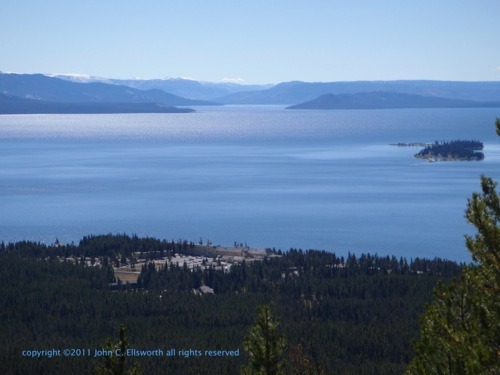
Yellowstone Lake
Operating under a Memorandum of Understanding with Yellowstone National Park, a coalition team of representatives from Trout Unlimited (ID, WY, and MT Councils and chapters as well as TU national), the National Parks Conservation Association, the US Geological Survey, and the Greater Yellowstone Coalition, is working to conserve the park’s native fish and save the Yellowstone cutthroat trout. This work is part of the TU National Leadership Council Western Native Trout Workgroup.
The coalition’s main goal is to raise funds to support Yellowstone National Park’s efforts to conserve native fish and save the Yellowstone cutthroat trout. Trout Unlimited Idaho Council and Chapters have raised significant funds already, but much more are needed. Opportunities and options for individual and group donations to help support these efforts will be described and made available after the presentations.
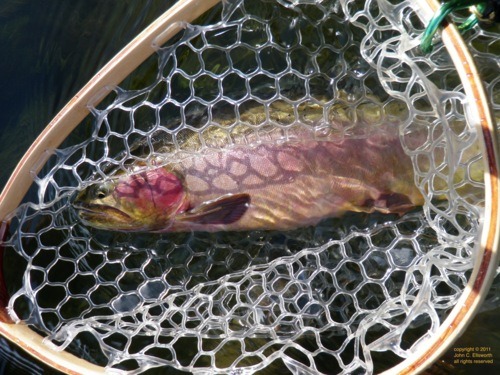
A netted Yellowstone cutthroat!
Please consider making a donation now. You can send a check made out to: Idaho Council of Trout Unlimited, P.O. Box 1971, Boise, ID 83701 (write “Save the Yellowstone Cutthroats” on the memo line of the check), or simply click the link below to give using a credit card or PayPal.
Suggested donation levels are tied to prices of the specific equipment needed to complete the telemetry tracking research: $400 (buys one standard hydro-acoustic telemetry tag), $700 (buys one depth-recording hydro-acoustic telemetry tag), and $1,400 (buys one signal receiver), but of course any amount you can afford to donate is deeply appreciated! For further information, contact John Ellsworth, Vice President of Idaho Council of Trout Unlimited, at johnsworth123 at yahoo dot com. Thank you in advance for helping us “Save the Yellowstone Cutthroats”!
To READ PREVIOUS BLOG POSTS on the campaign to Save the Yellowstone Cutthroats, click below:
Dec 31, 2012 — Top 10 2012 Trout and Salmon Tales
Oct 14, 2012 — Update on Yellowstone Cutthroat Trout
May 30, 2012 — We Have Exceeded our $85,000 Goal for Yellowstone!
April 24, 2012 — ITU Runs 10k: Idaho Trout Unlimited raises $10,000 for Yellowstone Cutthroat Trout Conservation
Feb. 17, 2012 — Magic Valley Fly Fishers Saving the Yellowstone Cutthroat
Jan. 24, 2012 — More Progress on Saving Yellowstone Cutthroat Trout in Yellowstone Lake
Dec. 19, 2011 — Conserving Native Fish, and Saving the Yellowstone Cutthroat Trout, in Yellowstone National Park
Oct. 14, 2011 — Update on Yellowstone Cutthroat Trout


